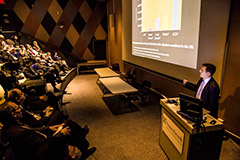The heart of innovation
By Alisa Kim
On Nov. 25, 2013, Sunnybrook Research Institute (SRI) hosted its annual Schulich Heart Program Research Day. In one of the most robust turnouts in the event's history, more than 200 scientists, clinicians and trainees packed Sunnybrook's Harrison Hall to learn about cutting-edge research in cardiovascular medicine.
Dr. Graham Wright, director of the Schulich Heart Research Program at SRI and one of the event organizers, welcomed the capacity crowd and outlined the day's research themes: cardiovascular outcomes and health services, imaging, and emerging interventions and therapies. "I look forward to an interactive day. We encourage people to ask questions and have conversations. This is an opportunity to see new ideas for the coming year and review where we've been over the past year," said Wright.
Dr. Martin Myers, a senior scientist at SRI and a cardiologist at Sunnybrook, gave the opening keynote lecture. He summarized findings from studies he has carried out over his 40-year career, including his focus on automated blood pressure measurement.
The second keynote lecture was by Dr. James White from the University of Calgary. He argued that cardiovascular magnetic resonance imaging (MRI) is a versatile tool that can help doctors determine which patients are best suited to specific treatments. He noted that improved response rates to therapies could lead to better patient outcomes and savings to the health care system.
In the second session on cardiovascular imaging, Dr. Charles Cunningham, a senior scientist in Physical Sciences at SRI, discussed his research on metabolic imaging of the human heart. He is developing a method that uses a novel MRI contrast agent—hyperpolarized carbon-13-labelled pyruvate—to detect metabolic changes in heart tissue cells that are indicative of disease. For example, studies show that one of the early characteristics of heart failure is depletion of energy, needed for the heart to pump blood to the rest of the body.
The technique uses a biomolecule—specifically, pyruvate that has had one of its carbons swapped with carbon-13—and a process called dynamic nuclear polarization to dramatically increase its visibility in an MRI scanner. The pyruvate is prepared in a strong magnetic field at a very low temperature and then rapidly warmed to room temperature and injected via a syringe. Using MRI, Cunningham observes the pyruvate and ensuing chemical reactions in the body, which show how cells are functioning. In preclinical models of heart failure, he found an early decrease in the production of glutamate due to energy depletion.
One of the challenges of the technique is the short period of polarization; he has one minute to inject the solution intravenously into the subject in the MRI scanner. Another is quality control; to use the technique in patients the hyperpolarized molecules must be sterile. This year SRI acquired a clinical polarizer that can make sterile products as part of its Centre for Research in Image-Guided Therapeutics.
Cunningham is poised to begin patient studies of cardiac hypertrophy (thickening of the heart muscle), which is a predictor of heart failure. He plans to start this research in a few weeks, at which time SRI will become the second site in the world to study this technique clinically.
The third keynote lecture was by Dr. Paul Dorian, a professor of medicine at the University of Toronto, who spoke on challenges and successes in cardiac resuscitation. He outlined goals to improve response to cardiac arrest, a condition in which the heart suddenly and unexpectedly stops beating. These include promotion of bystander CPR (cardiopulmonary resuscitation), education to improve earlier and more effective use of automated external defibrillators and interventions such as cardiac catheterization once patients are admitted to hospital.
Wright closed the day by thanking the speakers and attendees for their participation and invited everyone to the Schulich Innovation Research Day in June.



